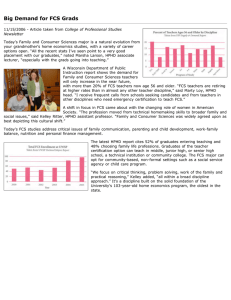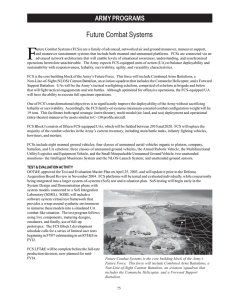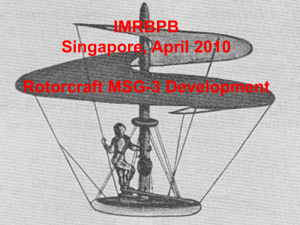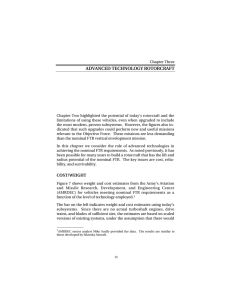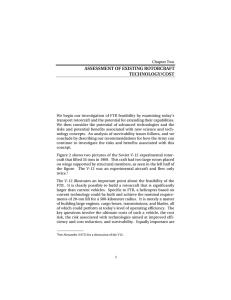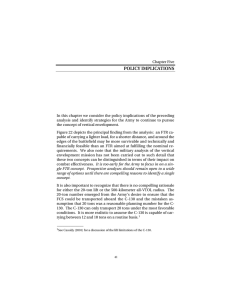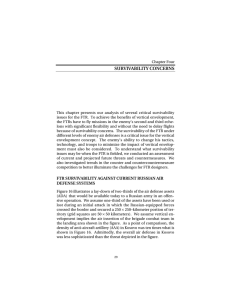INTRODUCTION
advertisement
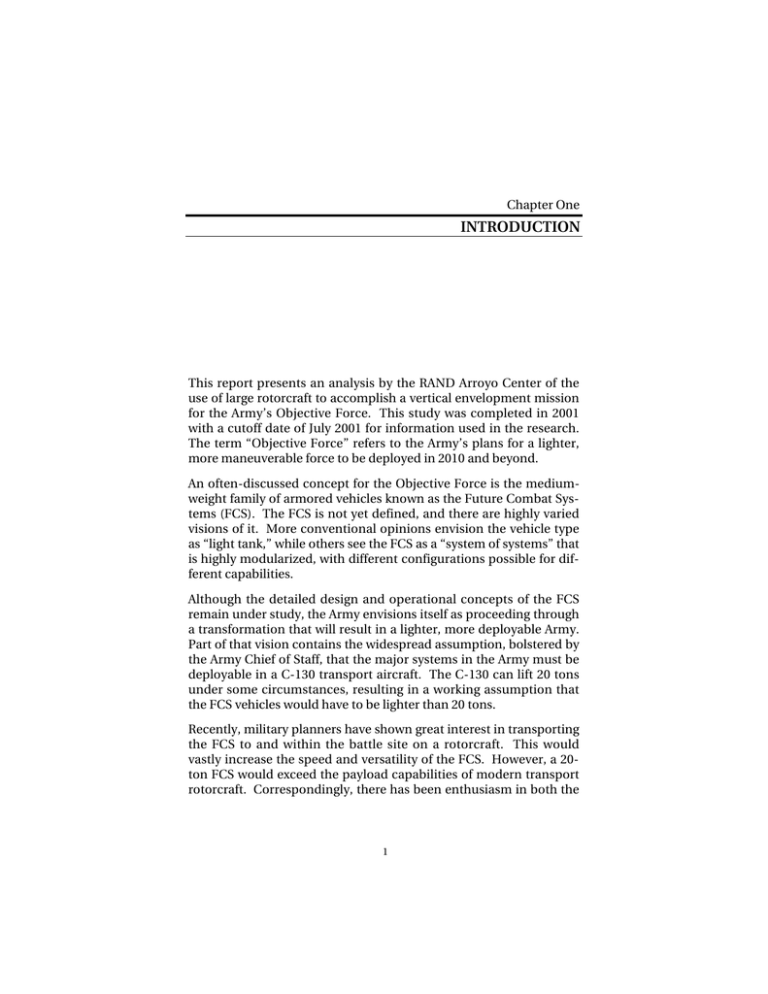
Chapter One INTRODUCTION This report presents an analysis by the RAND Arroyo Center of the use of large rotorcraft to accomplish a vertical envelopment mission for the Army’s Objective Force. This study was completed in 2001 with a cutoff date of July 2001 for information used in the research. The term “Objective Force” refers to the Army’s plans for a lighter, more maneuverable force to be deployed in 2010 and beyond. An often-discussed concept for the Objective Force is the mediumweight family of armored vehicles known as the Future Combat Systems (FCS). The FCS is not yet defined, and there are highly varied visions of it. More conventional opinions envision the vehicle type as “light tank,” while others see the FCS as a “system of systems” that is highly modularized, with different configurations possible for different capabilities. Although the detailed design and operational concepts of the FCS remain under study, the Army envisions itself as proceeding through a transformation that will result in a lighter, more deployable Army. Part of that vision contains the widespread assumption, bolstered by the Army Chief of Staff, that the major systems in the Army must be deployable in a C-130 transport aircraft. The C-130 can lift 20 tons under some circumstances, resulting in a working assumption that the FCS vehicles would have to be lighter than 20 tons. Recently, military planners have shown great interest in transporting the FCS to and within the battle site on a rotorcraft. This would vastly increase the speed and versatility of the FCS. However, a 20ton FCS would exceed the payload capabilities of modern transport rotorcraft. Correspondingly, there has been enthusiasm in both the 1 2 Vertical Envelopment and the Future Transport Rotorcraft FCS and rotorcraft communities for a new rotorcraft that might be able to manage such loads over useful ranges. Figure 1 shows a simple schematic of the vertical envelopment mission. It also highlights the nominal requirements that have been discussed and highlighted in other briefings and studies. We should, however, emphasize that the word “nominal” implies that there are no firm requirements for the Future Transport Rotorcraft (FTR). Figure 1 depicts the FTR as either a traditional helicopter or a tiltrotor, capable of carrying an FCS in a cargo box with a volume equivalent to that of a C-130 transport aircraft. The vehicle would have sufficient range and payload to conduct a 500-kilometer radius (there and back) mission with vertical takeoffs and landings (VTOLs) at standard Army flight design conditions of 4,000-foot altitude and 95 o F. It is assumed that the vehicle will be able to move the FCS around the battlefield and, hence, will need to repeatedly penetrate enemy air defenses. RANDMR1713-1 Future Transport Rotorcraft (FTR) 500-km radius 20-ton FCS Enemy air defense and forces C-130 size cargo box Figure 1—Vertical Envelopment and the Objective Force Introduction 3 We emphasize that the nominal design and operating parameters are not fixed. They do, however, serve as a starting point for analysis of the vertical envelopment mission in the context of the Objective Force. The concept also depends on compatibility between the FCS and FTR designs. Some refer to the two programs as being “joined at the hip,” though the FCS has a targeted deployment of 2010 while the often-discussed target date for the FTR is 2015. At this point, both dates appear optimistic, but it is not too early for there to be significant technical interchange between the two programs. Those examining the future requirements of the Objective Force have identified an FTR capability as a dramatic force multiplier. Using wargames and high-resolution simulation modeling, Army “futurists” have demonstrated that if the rotorcraft can penetrate enemy defenses successfully, there are distinct benefits to deploying the FCS quickly and beyond enemy lines.1 The deployed units can assume defensive positions in what was an offensive operation. These benefits are achieved with minimal collateral damage and are especially effective in complex-terrain settings where targets are difficult to find. The Army’s rotorcraft community is equally enthusiastic about the FTR concept. The Army has sponsored a number of rotorcraft science and technology (S&T) programs for many years. Managers of these programs are optimistic that they can be used to develop an FTR concept that is affordable and feasible. Although both Army military planners and technologists are attracted to the FTR, senior Army policymakers responsible for balancing a wider range of considerations have voiced skepticism. Some are concerned about the technical and financial feasibility of a rotorcraft capable of carrying 20 tons in an all-VTOL mode to a radius of 500 kilometers. They have also expressed interest in understanding the “knee in the curve,” that is, the point at which the technical challenges and uncertainties begin to grow and produce diminishing performance benefits. These considerations are important because ______________ 1 See Matsumura et al. (2000) and TRADOC Analysis Center (2000) for examples of modeling and wargames that validate the utility of the vertical envelopment concept under conditions where FTR survivability is not a factor. The former report also discusses survivability issues. 4 Vertical Envelopment and the Future Transport Rotorcraft the nominal mission parameters are the basis for early discussion only. Ultimate mission needs might be altered, both for military reasons and for issues of cost and technical factors associated with either the rotorcraft or the FCS. In addition to financial and technical questions, there are military issues that require further analysis. There is, of course, the need to better highlight the potential military benefits of vertical envelopment, but perhaps an even greater issue lies in the survivability of the large rotorcraft as it penetrates enemy lines. As noted above, the benefits of vertical envelopment occur only if the rotorcraft has freedom to move flexibly about the battlefield. While it is not necessary to resolve all of these issues, it is important to provide enough definition to help structure the Army’s Integrated Concept Team (ICT) effort. An ICT is one of the first steps in the military system acquisition process and is used to analyze needs and provide a more explicit definition of a system to fulfill those requirements. More generally, the purpose of this report is to help the Army develop the FTR-FCS trade space. To date, the force developers have viewed the FTR as a “point design” concept, which either meets nominal vertical envelopment requirements or does not. Feasibility is tied to cost and technical risk, and there are many alternative design goals for an FTR. We note that the Army and rotor and fixedwing aircraft developers have studied a range of aircraft for this application. This document endeavors to identify those complex factors so that the Army can make better choices with regard to the evolution of this technology.

